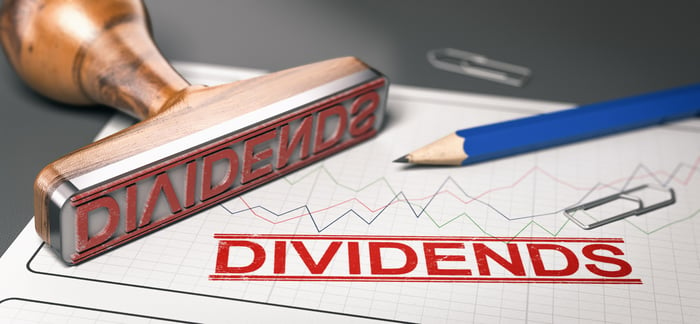Dividend stocks are a tempting source of passive income, but many investors might consider the dividend yield of individual stocks only at face value. For instance, Hormel Foods (HRL -1.17%) yields 2.4%, and Chevron (CVX 0.53%) is offering a dividend yield of 3.5%. Based on these yields alone, which is the better dividend stock?
If the only thing you consider is the absolute level of the dividend yield, you risk making a very big mistake. Here's why it may be even more important to think about yield in a relative sense.
Basic math
A share of stock is a claim on the future cash flows that a company is expected to produce. A dividend is a cash return on that claim, usually paid quarterly. Dividend yield is a way to quantify that return and is as simple as annualizing the current quarterly dividend and dividing it by the current stock price to arrive at a percentage. Higher yields indicate higher cash returns.

Image source: Getty Images.
The problem is that, in isolation, the dividend yield only provides so much information. For example, Hormel's yield is lower than Chevron's yield, so investors will collect more dividends from the energy giant than from the food maker. However, there are entire sectors of the market that generally have high yields, such as real estate investment trusts (REITs) and utilities, and areas that generally provide only modest yields, like technology. Looking at absolute yield alone isn't enough to help dividend investors choose between specific investment options.
This is why relative dividend yield is actually a more powerful tool. In essence, you compare a company's yield to the company's own yield history. This effort provides you with a way to consider valuation.
P/E ratio vs. relative yield
As soon as most investors hear the word valuation, the price-to-earnings ratio (P/E) probably comes to mind. It is the most commonly used valuation tool, but it suffers from a major drawback. Earnings are highly variable from year to year, let alone from quarter to quarter. And then there are the differences that show up between generally accepted accounting principles (GAAP)-based earnings and the "adjusted" earnings many companies report, which often remove items that reduce GAAP-based earnings. For this reason, earnings simply aren't a particularly consistent measuring stick.
Dividends, on the other hand, tend to be very consistent over time. Companies don't like to cut dividends because investors often punish the shares when that happens. So a company generally only increases dividends when that company believes it can support the payments over the long term.
In some ways, dividends provide a better look at a company's business prospects over time. (For reference, Chevron has increased its dividend annually for 36 years and Hormel for 57 years, making it a highly elite Dividend King.) Thus, a high yield compared to a company's history can suggest a historically attractive entry point for long-term dividend investors.
Going back to the stock comparison above -- Hormel or Chevron? Using the absolute level of the dividend, Chevron clearly wins. But, if you look at Chevron's yield history, the 3.5% yield on offer today is toward the low end of its historical yield range.
Energy is a highly cyclical industry, and Chevron has done a wonderful job navigating the ups and downs over time. But today, energy prices are fairly high, and Chevron is posting strong financial results. Investors have bid the stock up over 200% since the worst of the bear market in 2020 (around mid-March of that year) when energy prices were plunging on falling oil demand during the early days of the coronavirus pandemic. Relative yield shows clearly that Chevron is not cheap today. For reference, the stock's P/E is around 9 times annual earnings, which many would consider fairly modest.
CVX Dividend Yield data by YCharts
Hormel, on the other hand, has a lower yield than Chevron, at 2.4%, but the yield is actually toward the high end of Hormel's historical yield range. Despite the lower absolute yield, Hormel's stock looks relatively cheap. Looking back to mid-March 2020, the stock is actually down a little over 5%. The stock's P/E is around 24 times annual earnings, which most would consider high. And yet, looking at relative rather than absolute dividend yield, Hormel is probably a better option for dividend investors with a value bias.
Do your homework
Chevron versus Hormel is a cherry-picked example, and they are from two vastly different industries, so you have to take this matchup with a grain of salt. However, it does clearly show that dividend yield alone isn't enough to make an investment decision. That said, relative yield isn't, either. Hormel is a good example because it happens to be a financially strong company with solid long-term growth prospects and an incredible dividend history. That can't be said of every company offering a historically high yield. Sometimes the high yield is a warning that a dividend cut is in the cards.
In other words, relative yield is a good starting point, but you need to do more research. Even with its drawbacks, however, if you incorporate relative yield into your investment tool box, you are very likely to find it a valuable way to identify highly attractive dividend stocks.




